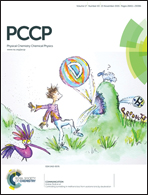Combined theoretical and time-resolved photoluminescence investigations of [Mo6Bri8Bra6]2− metal cluster units: evidence of dual emission†
Abstract
The combined time-resolved photoluminescence (PL) and theoretical study performed on luminescent [Mo6Bri8Bra6]2−-based systems unambiguously shows that their NIR-luminescence is due to at least two emissive states. By quantum chemical studies, we show for the first time that important geometrical relaxations occur at the triplet states either by the outstretching of an apex away from the square plane of the Mo6 octahedron or by the elongation of one Mo–Mo bond. Experimental PL measurements demonstrate that the external environment (counter-ions, crystal packing) of the cluster has a noticeable impact on its relaxation processes. Temperature and excitation wavelength dependence of the two components of the luminescence spectra is representative of multiple competitive de-excitation processes in contradiction with Kasha's rule. Our results also demonstrate that the relaxation processes before and after emission can be tracked via fast time-resolved spectroscopy. They also show that the surroundings of the luminescent cluster unit and the excitation wavelength could be modulated for target applications.
![Graphical abstract: Combined theoretical and time-resolved photoluminescence investigations of [Mo6Bri8Bra6]2− metal cluster units: evidence of dual emission](/en/Image/Get?imageInfo.ImageType=GA&imageInfo.ImageIdentifier.ManuscriptID=C5CP03960F&imageInfo.ImageIdentifier.Year=2015)

 Please wait while we load your content...
Please wait while we load your content...